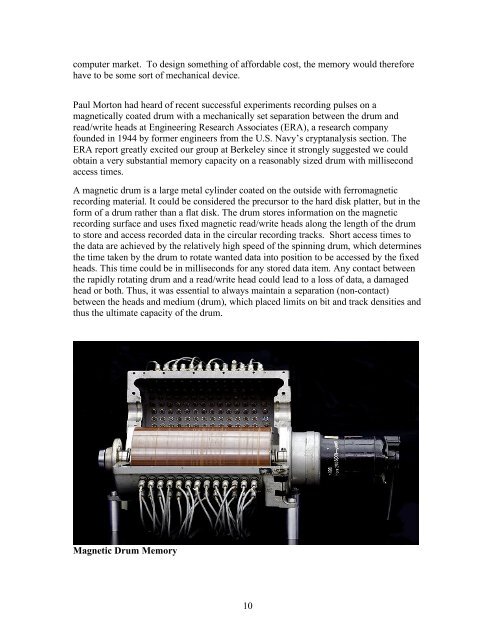final book al hoagland - Archive Server - Computer History Museum
final book al hoagland - Archive Server - Computer History Museum
final book al hoagland - Archive Server - Computer History Museum
Create successful ePaper yourself
Turn your PDF publications into a flip-book with our unique Google optimized e-Paper software.
computer market. To design something of affordable cost, the memory would therefore<br />
have to be some sort of mechanic<strong>al</strong> device.<br />
Paul Morton had heard of recent successful experiments recording pulses on a<br />
magnetic<strong>al</strong>ly coated drum with a mechanic<strong>al</strong>ly set separation between the drum and<br />
read/write heads at Engineering Research Associates (ERA), a research company<br />
founded in 1944 by former engineers from the U.S. Navy’s cryptan<strong>al</strong>ysis section. The<br />
ERA report greatly excited our group at Berkeley since it strongly suggested we could<br />
obtain a very substanti<strong>al</strong> memory capacity on a reasonably sized drum with millisecond<br />
access times.<br />
A magnetic drum is a large met<strong>al</strong> cylinder coated on the outside with ferromagnetic<br />
recording materi<strong>al</strong>. It could be considered the precursor to the hard disk platter, but in the<br />
form of a drum rather than a flat disk. The drum stores information on the magnetic<br />
recording surface and uses fixed magnetic read/write heads <strong>al</strong>ong the length of the drum<br />
to store and access recorded data in the circular recording tracks. Short access times to<br />
the data are achieved by the relatively high speed of the spinning drum, which determines<br />
the time taken by the drum to rotate wanted data into position to be accessed by the fixed<br />
heads. This time could be in milliseconds for any stored data item. Any contact between<br />
the rapidly rotating drum and a read/write head could lead to a loss of data, a damaged<br />
head or both. Thus, it was essenti<strong>al</strong> to <strong>al</strong>ways maintain a separation (non-contact)<br />
between the heads and medium (drum), which placed limits on bit and track densities and<br />
thus the ultimate capacity of the drum.<br />
Magnetic Drum Memory<br />
10
















